“Whatever its origins, the Southern California bungalow, as it flourished in the early 1900s, constituted a dramatically successful solution to the challenge of creating moderately priced, regionally suitable domestic architecture.” - Kevin Starr, Material Dreams
A Type, A Style, An Idea
One hundred years ago, Los Angeles grew large and fast. The proliferation of affordable bungalows made this urban expansion possible. In the decades before World War II, thousands of Americans moved West in search of opportunities. Many purchased bungalows, a building type that had also recently arrived in California. As an architecture of international provenance, bungalows adapted well to this new setting. They spread across the region, covering the landscape like poppies in bloom. Since then, less sustainable domesticities have supplanted the bungalow lifestyle in Los Angeles. Today, a paucity of affordable housing besets the City of Angels, which can’t remain a town of new beginnings without cheaper places to live.
Bungalows, those ubiquitous but inconspicuous monuments to Los Angeles’s past, shed light on this complex housing crisis.
The bungalow has a complicated history made more confusing by the word’s imprecision. Architectural historian Robert Winter even speculates that, “The beginning of the bungalow’s demise might be found in the looseness of the definition.” During the heyday of its successor, the ranch house, bungalow became a vague term of derision. ‘Bungalow’ originally denoted a traditional Bengalese domicile. The British adapted this native architecture into their own bungalow variants during the colonial period. Other languages have since borrowed the word to describe various domestic buildings, from beach houses to urban cottages, producing a globally diverse bungalow genealogy.
One architectural descendant emerged in California during the early 20th Century. A versatile and simplified craftsman aesthetic, this ‘California bungalow style’ counterintuitively includes small houses as well as mansions (which Randell Makinson calls ‘ultimate bungalows’). Concurrently in Los Angeles, developers began arranging bungalows in pocket neighbourhoods called bungalow courts. The oldest of these small communities consist of California bungalows organised around semi-public space, but newer courts conform to other popular architectural styles.
Bungalow connotes more than one typology, style and idea about living. Yet every manifestation generally embodies several architectural principles: material efficiency, spatial simplicity, regional sensitivity and local community. At a time when affordable housing is scarce, these values are as relevant now as they were a century ago.
From India to California
The specific nature of California’s bungalows dates back to an Indian vernacular archetype. The word itself is an anglicisation of the Hindi name for a rustic Bengalese hut, a bangla. Mughal peasants constructed these dwellings out of available local resources, predominantly mud, bamboo and thatch. Banglas had simple interior configurations, probably one room and a gabled roof that might overhang to cover a porch. When families grew richer or larger, they built additional huts nearby instead of remodelling their original one.
During the British occupation of the subcontinent, architectural acculturation produced a kind of Anglo-Indian bungalow. How the indigenous bangla transformed into the imperial bungalow remains unclear; however, historians such as Anthony D. King hypothesise it’s actually an amalgam of multiple buildings. Colonists appropriated local building traditions to create a hybrid architecture for themselves and the resultant Anglo-Indian bungalows functioned as outposts of provincial administration. Not intended for long term habitation, these houses were constructed of inexpensive materials; sun-dried mud block walls and thatched or tiled roofs were common. The typical floor plan consisted of a large central area surrounded by smaller rooms enclosed under the verandah. Overall, they were much bigger than banglas.
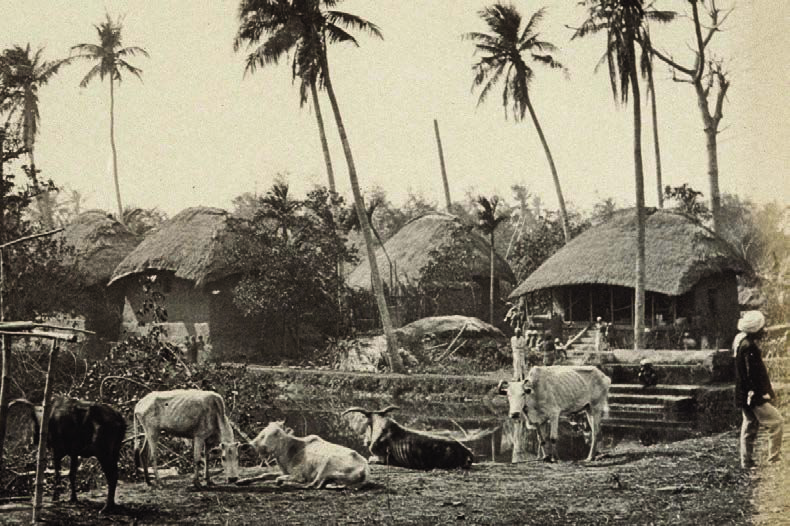
Source: Los Angeles County Museum of Art
India eventually exported the idea of the bungalow throughout the British Empire. Their form and use further westernised in the United Kingdom, where bungalows were built as summer houses and retreats. These buildings reached America by way of design magazines during the latter half of the 19th Century. The East Coast architectural establishment hardly distinguished bungalows from common cottages, in part because they’d become stylistically diluted in Great Britain. However, designers in the American Midwest revived the essence of the bungalow. It’s perhaps no coincidence that the same region pioneered Prairie School architecture, which also emphasises horizontality, porches and the centrality of the hearth.
While the bungalow came to the East Coast via architectural literature, it reached California through consumer catalogues. Midwestern entrepreneurs advertised numerous designs in ‘bungalow books’ that were usually free. In the 1910s, a complete drawing set for a catalogue house might cost $5, which could be built for as little as $500.
The house’s components were commonly pre-cut and shipped to California to be assembled on site. At that time, many of the state’s newly-arrived residents ordered bungalows from companies like Aladdin Homes, but unlike their contemporaries on the eastern seaboard or the UK, Californians occupied them as their primary residence.
Setting a humble tone following his resignation from the presidency, Richard Nixon began his memoirs by reflecting, “I was born in a house my father built.” The president’s birthplace is actually a bungalow that his dad, a citrus farmer, ordered as a kit and constructed on his grove in Yorba Linda, a rural community at the periphery of Los Angeles. Nixon’s recollection suggests how bungalows enabled upward economic mobility. Many Californians of his generation could relate to his origin story.
Land in and around Los Angeles was unimaginably cheap back then and affordable bungalows defined the city’s early urbanization. The first homes were available from Midwestern businesses, but soon enough, developers and architects also moved to Los Angeles and fostered a local design culture. Here, bungalows became the architecture of the working and middle classes. They came full circle during their translation from India to California: beginning as modest abodes, appearing around the world as residences of privilege and flourishing in Los Angeles as affordable housing.
The Architecture of Bungalows
The ‘California Bungalow’ is perfectly suited for life in Los Angeles and as a result became a defining constituent of its built environment. Americans moved there in search of an arcadian ideal, but the ensuing growth paradoxically made Los Angeles into a metropolis. Bungalows fulfilled an American fantasy by balancing the city and the country. They connected occupants to the manicured nature of exurban Los Angeles, thereby breaking down a rigid dichotomy between architecture and landscape.
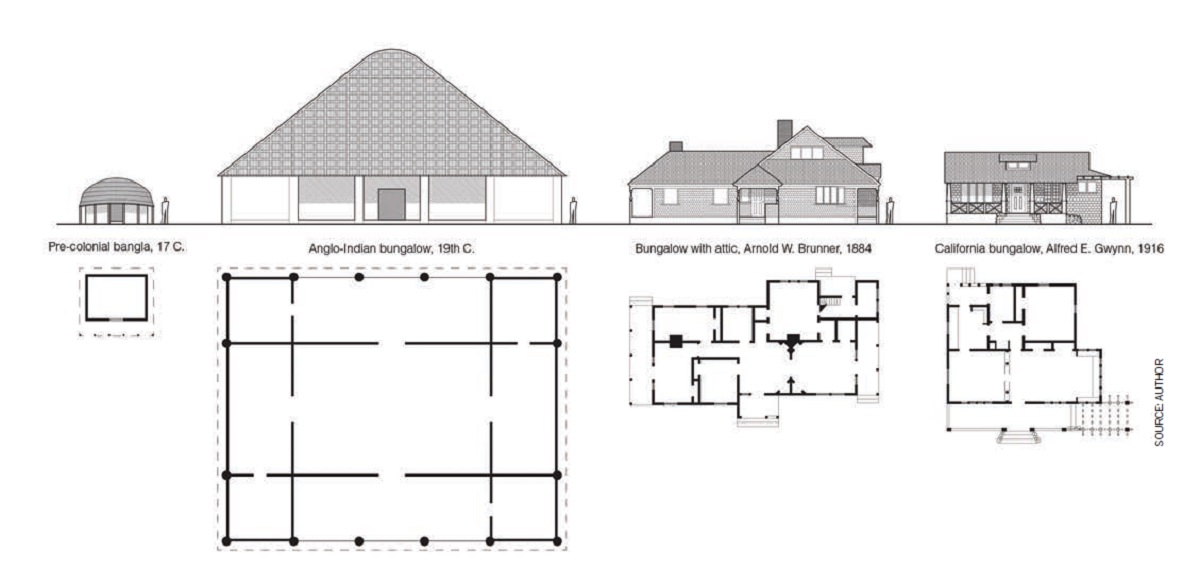
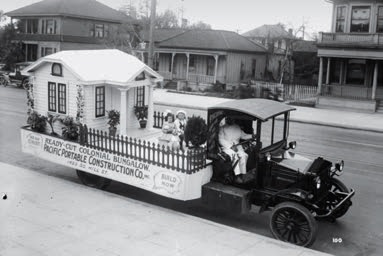
Source: University of Southern California Libraries & The California Historical Society
The porch is the primary architectural apparatus that realises this indoor/outdoor experience. California bungalows have generous porches that constitute most, if not all, of the street-facing facade and sometimes the side of the house too. As a later incarnation of the Indian verandah, the porch functions as an outdoor room, extending domestic space to the house exterior. Lucky Angelenos can enjoy the region’s warm weather from a bungalow porch, which shades them from direct sunlight. Porches are deep to prevent the high summer sun’s rays from penetrating and overheating the inside of the house and shallow enough to allow the lower winter sun to brighten and warm the bungalow during colder months. Presaging early modernism’s emphasis on glass, California bungalows enjoy abundant glazing that pleasantly illuminates their interiors and establishes a visual connection to the outside.
The relaxed distinction between interior and exterior promotes an informal California lifestyle, one that is also reflected in a minimalistic plan. Public space is concentrated in the front of the house, with private and service rooms in the back. Behind the porch, the front section of the bungalow is almost always bifurcated into a living room and a dining room. The two are essentially the same space, with flanking pony walls delineating the programmatic difference. ‘Open concept’ floor plans are currently in vogue on real estate television programmes, but the bungalow epitomised this domestic flow a century ago.
Bungalows are designed somewhat like boats, as both achieve spatial economy and multivalency. Unlike an earlier Victorian home, which would prominently feature a foyer, a bungalow has only the living room. This space is both entry and hearth, evincing a functionalist philosophy. This resourcefulness is also evident in the aforementioned pony walls and built-in seats, which also cleverly serve as storage space. Bungalow plans include one hallway, if any at all, and small closets by contemporary standards.
American Studies scholar Clifford Edward Clark, Jr. describes the California bungalow as the embodiment of a ‘spartan ethic’, the architectural repudiation of Victorian domestic pretensions. Even though early bungalows stylistically adhere to the Arts & Crafts movement, many were prefabricated like their Victorian predecessors.
This industrial manufacture, combined with their compact design, reduced the cost of a bungalow and made home ownership attainable for more Americans.
The Urbanism of Bungalows
Intact bungalow neighbourhoods remain charming places today. Some are disadvantaged by poverty and prejudice, but these communities are, nonetheless, rich in architecture and urban design. Bungalow urbanism exists at two scales, which architect Stefanos Polyzoides identifies as ‘the Street and the Court’.
The larger scale ‘street’ refers to entire blocks of bungalows. As bungalows aren’t as wide as American postwar tract houses, their lots tend to be smaller as well. More bungalows can therefore fit on a street, resulting in modestly denser neighbourhoods than in most suburbs. These streets also prioritise pedestrians over automobiles. They’re narrower than contemporary American suburban streets, which reduces car speeds and improves neighbourhood safety. In postwar developments, an attached garage is frequently a home’s focal point. However, bungalows have detached garages hidden in backyards so porches take architectural precedence. In addition to nature, porches connect bungalows to the community. As a social device, porches provide a public vantage point from which to greet neighbours and as a safety precaution they enable Jane Jacob’s ‘eyes on the street’. Bungalow neighbourhoods are, well, just more neighbourly.
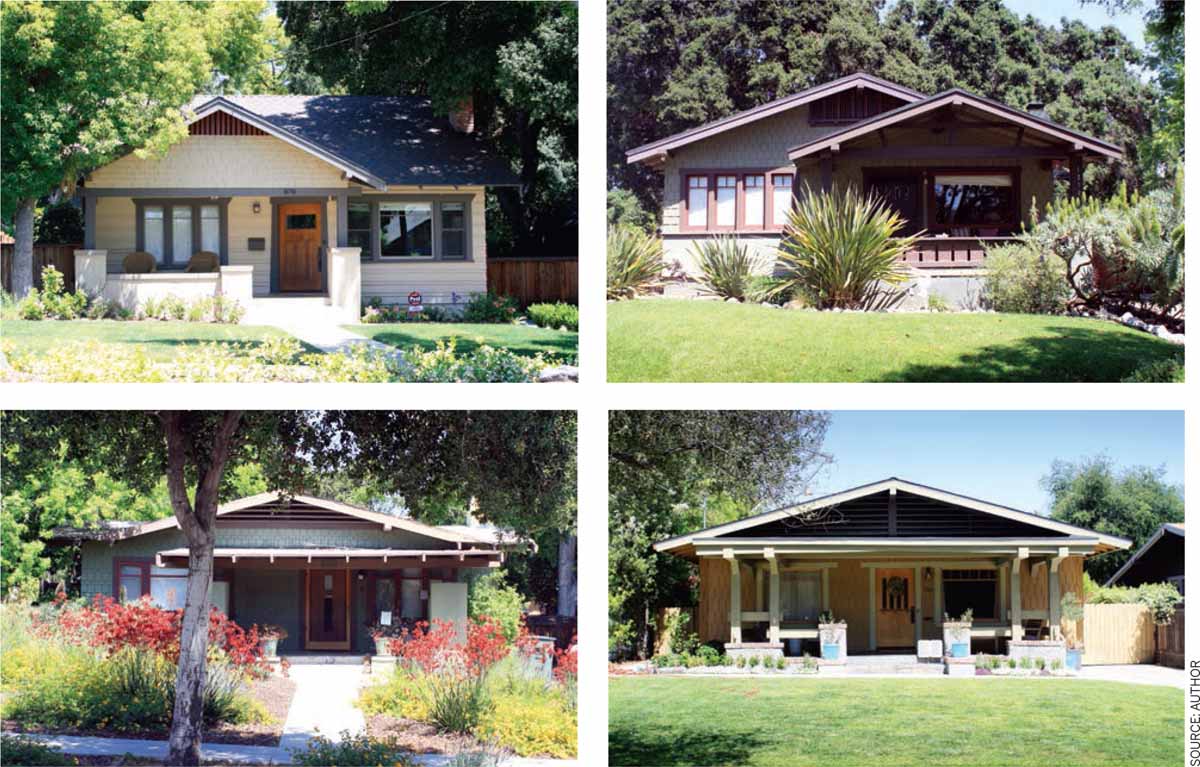
In Pasadena, a city adjacent to Los Angeles, the Bungalow Heaven Landmark District is a pristine example of bungalow urbanism. This 16-block area is listed on the National Register of Historic Places and remains one of Pasadena’s most desirable neighbourhoods. It is also out of reach for the average person. According to digital real estate company Redfin, the median home price is just shy of $ 1,000,000. It’s ironic that modest housing from the turn of the century is luxury housing today. Bungalow neighbourhoods are clearly in demand, but quality urbanism is a commodity that few can afford.
On a much smaller scale, bungalow urbanism manifests as pocket neighbourhoods called bungalow courts. California’s most significant contribution to the history of bungalows isn’t their design, but rather their arrangement. Sylvanus Marston likely invented the bungalow court in 1909 when he proposed Saint Francis Court, also in Pasadena. Now demolished, this specific development was intended as a cluster of expensive rentals for rich people, though subsequent projects catered to the middle and working classes. These courts often consist of true, one-storey bungalows, but in other cases several semi-bungalows or ultimate bungalows are subdivided into multi-family buildings around a shared lawn. Big or small, they attract people at various stages of life, from individuals, to young families and elderly couples too.
These courts basically apply the design intent of bungalows to entire communities. Courts use space efficiently by fitting multiple units on one lot. Depending on a development’s size, bungalows may share a common green, courtyard or planted walkway. Like the porch, these communal spaces serve as transitional zones between the house (private) and the street (public). The urban qualities of a bungalow street are more amplified in a court, as the latter is more intimate. In Los Angeles, bungalow courts historically reduced dependence on cars because they were often built near public transportation. Thus, they represent an archetypal model of the transit-oriented development that’s popular now.
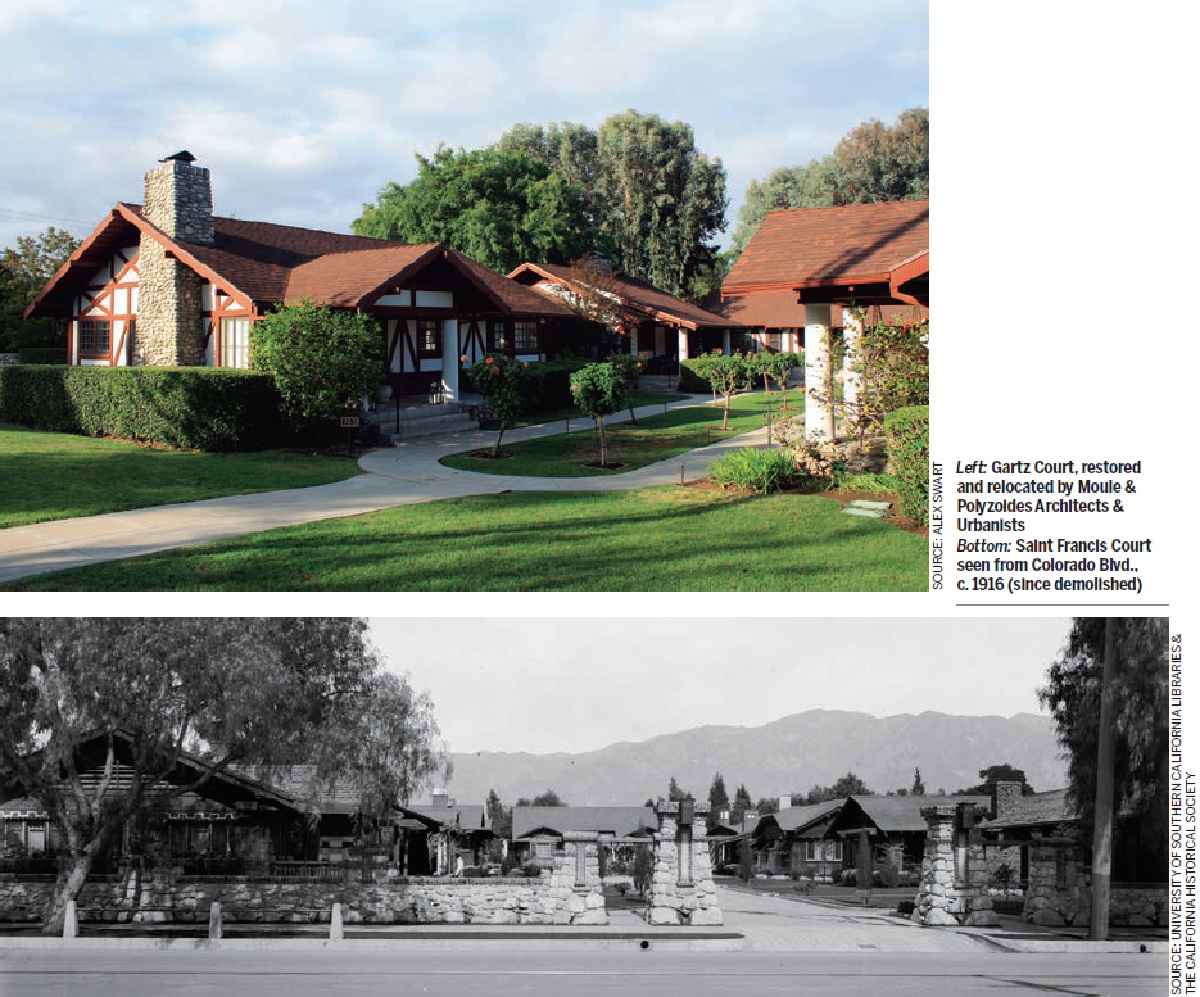
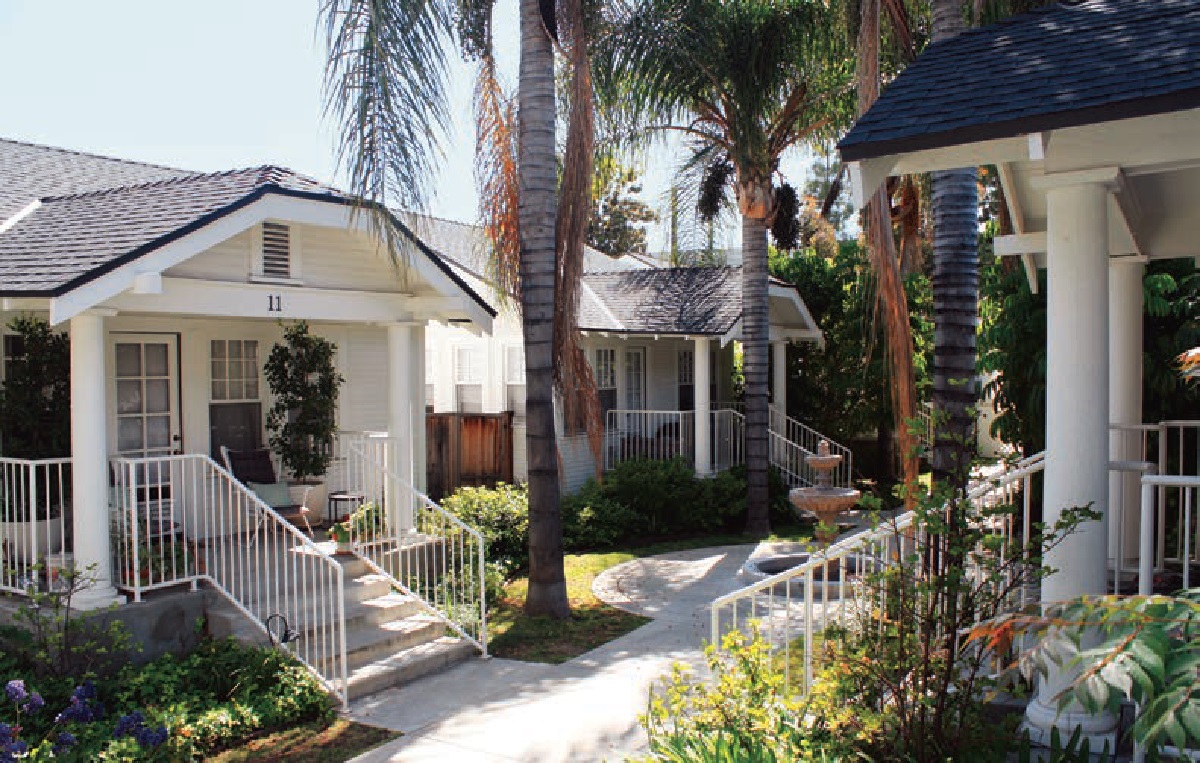
Source: Alex Swart
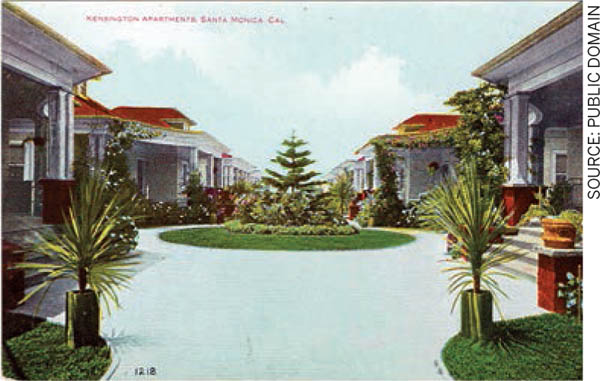
Learning from Los Angeles
In the decades since the bungalow era, bad urban policy and development have beleaguered Los Angeles. Measure S brought these issues to the forefront of a recent local election. This ballot initiative claimed to rectify the uncertainty and perceived unfairness of the city’s outdated planning procedure. It would have barred granting General Plan amendments, even though many higher density projects with affordable units rely on zoning variances.
Measure S lost by a decisive margin, but the debate around it reveals the electorate’s anxieties about future growth. Measure S exploited fears about rapid urbanization. While the initiative failed to constructively address that problem, those concerns remain valid. Urban planning dogma doesn’t recognise that suburban flight isn’t motivated by push factors alone.
Many people leave cities because they’re unaffordable and others choose suburbs out of a typological preference.
Urbanist Joel Kotkin argues that megacity density fails to foster family formation and the sizeable minority of Measure S supporters shows how some people reject this urban vision outright. Currently, neither the public nor private sectors provide a sufficient range of housing options.
Bungalows endure as testaments to affordable, beneficial urbanism. By virtue of low-tech sustainable design, bungalows reduce material use during construction and energy use throughout their life cycle, all of which translates into savings for the resident. Unlike the trendy tiny house movement, bungalows were envisioned as entire neighbourhoods, not one-offs. When configured as bungalow courts, they discreetly realise housing density in detached dwelling contexts. The bungalow court constitutes part of ‘The Missing Middle’, a range of housing between single family residences and mid-rise apartments. Karen Parolek of Opticos Design describes these underbuilt typologies as “naturally occurring affordable housing.” Cities with varied housing stock offer more options on a spectrum of densities. Living in Los Angeles would be possible across more demographics if the city adopted this paradigm.
California bungalows exemplify a ‘can-do’ attitude, a spirit of optimistic pragmatism. In their day, these homes were celebrated as both artistic and simple; Los Angeles’s current housing crisis requires similar architectural creativity and pragmatism. President Woodrow Wilson allegedly insulted the intelligence of his successor, Warren G. Harding, by saying he had a “bungalow mind”. A century later, however, today’s challenges demand a bungalow state of mind to imagine a liveable future for Los Angeles.

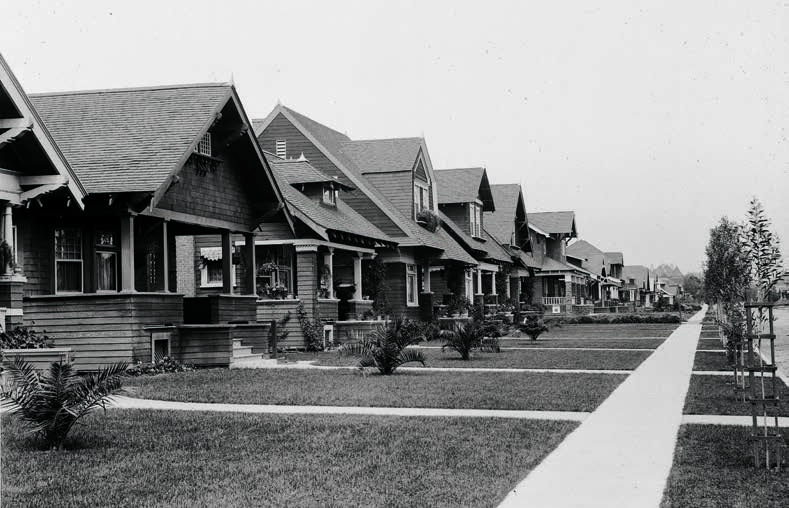

Comments (0)